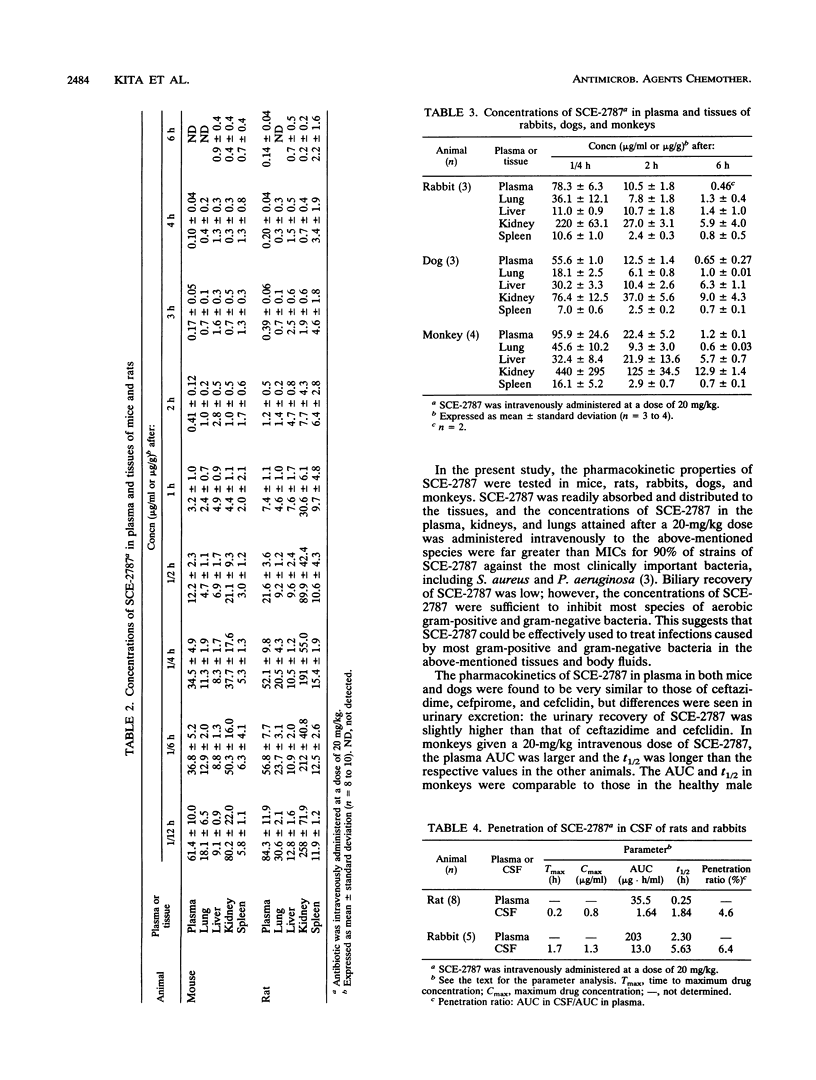Abstract
The pharmacokinetic properties of SCE-2787 administered intravenously at a dose of 20 mg/kg of body weight were studied with mice, rats, rabbits, dogs, and monkeys and were compared with those of ceftazidime, cefpirome, and cefclidin in mice and dogs. The area under the concentration-time curve for plasma after intravenous administration was the largest in monkeys, followed by those in dogs, rabbits, rats, and mice, in that order. The elimination half-life ranged from 0.2 to 0.3 h in mice and rats to 0.7 to 1.3 h in rabbits, dogs, and monkeys. In young dogs, the concentrations of SCE-2787 in plasma were somewhat lower than those in the mature dogs. SCE-2787 was distributed well to the tissues, and the highest concentration was found in the kidneys in all species tested; the distribution to the lungs, liver, and spleen was also good, but the concentrations in these tissues were lower than those in the plasma. The pharmacokinetic parameters and urinary excretion of SCE-2787 in mice and dogs were similar to those of ceftazidime, cefpirome, and cefclidin. The maximum concentrations in the cerebrospinal fluid of rats and rabbits were 0.8 and 1.3 micrograms/ml, and the relative percentages of the area under the concentration-time curve of SCE-2787 in the cerebrospinal fluid to that in the plasma were 4.6 and 6.4%, respectively. SCE-2787 was excreted mainly in the urine; the recovery rate ranged from 74% (rats) to 90% (dogs) of the dose. The biliary excretion of SCE-2787, however, was low, amounting to about 1.4% for mice and rats and less than 0.5% for rabbits and dogs. In rats, there was no accumulation in the tissues and no delay in urinary excretion upon multiple intravenous administration of 20 mg of SCE-2787 per kg once daily for 7 days. No active metabolites were found in the plasma or urine of animals given SCE-2787. The binding of SCE-2787 to serum protein in mice, rats, dogs, monkeys, and humans was less than 11% and similar to that of cefclidin.
Full text
PDF





Selected References
These references are in PubMed. This may not be the complete list of references from this article.
- D'Costa M., Cheng P. T. Ultrafiltrable calcium and magnesium in ultrafiltrates of serum prepared with the Amicon MPS-1 system. Clin Chem. 1983 Mar;29(3):519–522. [PubMed] [Google Scholar]
- Iwahi T., Okonogi K., Yamazaki T., Shiki S., Kondo M., Miyake A., Imada A. In vitro and in vivo activities of SCE-2787, a new parenteral cephalosporin with a broad antibacterial spectrum. Antimicrob Agents Chemother. 1992 Jul;36(7):1358–1366. doi: 10.1128/aac.36.7.1358. [DOI] [PMC free article] [PubMed] [Google Scholar]
- Morselli P. L. Clincial pharmacokinetics in neonates. Clin Pharmacokinet. 1976;1(2):81–98. doi: 10.2165/00003088-197601020-00001. [DOI] [PubMed] [Google Scholar]
- Nakao M., Noji Y., Iwahi T., Yamazaki T. Antibacterial properties of SCE-2787, a new cephem antibiotic. J Antimicrob Chemother. 1992 May;29(5):509–518. doi: 10.1093/jac/29.5.509. [DOI] [PubMed] [Google Scholar]
- Tsuji A., Terasaki T., Imaeda N., Nishide K., Nakashima E. Effect of extracellular water volume on the distribution kinetics of beta-lactam antibiotics as a function of age. J Pharmacobiodyn. 1985 Mar;8(3):167–174. doi: 10.1248/bpb1978.8.167. [DOI] [PubMed] [Google Scholar]
- Wise R. Protein binding of beta-lactams: the effects on activity and pharmacology particularly tissue penetration. I. J Antimicrob Chemother. 1983 Jul;12(1):1–18. doi: 10.1093/jac/12.1.1. [DOI] [PubMed] [Google Scholar]
- Yamaoka K., Tanigawara Y., Nakagawa T., Uno T. A pharmacokinetic analysis program (multi) for microcomputer. J Pharmacobiodyn. 1981 Nov;4(11):879–885. doi: 10.1248/bpb1978.4.879. [DOI] [PubMed] [Google Scholar]


